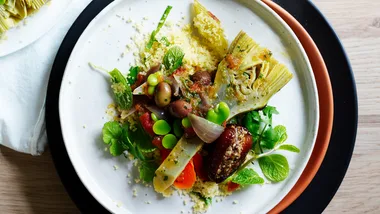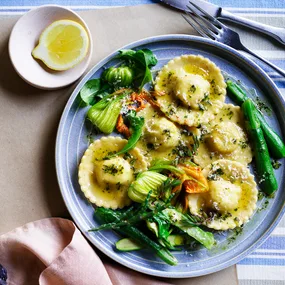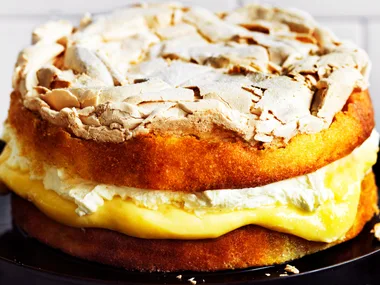At once sweet, tart and salty, this potent Mexican invention seduced Colman Andrews from the first sip.
In 1968, the novelist and gourmand Alec Waugh (brother of Evelyn) was able to write, in his Time-Life book Wines and Spirits, that “Tequila is not a drink that is ever likely to be popular among North Americans, whose palates have not been hardened by the unrestrained use of chili [sic].” Ha! Today, more than 12 million cases of tequila are sold in the US annually, with imports of the agave-based spirit jumping 61 per cent between 2002 and 2012. Australia consumes considerably less; exact figures are hard to come by, but it doesn’t figure in the top 10 countries for tequila sales.
In Mexico, the traditional way to drink tequila was straight, in shots, accompanied by nothing more than lime and salt or small glasses of sangrita, a tart non-alcoholic concoction of various citrus juices and chilli powder (some variations add tomato or pomegranate juice) The spirit is otherwise found in a drink called the Paloma, said to be the country’s most popular tequila cocktail, which is simply the liquor mixed with grapefruit soda (Jarritos is a common brand) and lime juice.
In America, we have figured out countless ways to work tequila into cocktails. There are many, among them the Bloody Maria (a tequila Bloody Mary), the Brave Bull (tequila and Kahlúa on the rocks) and the Tequila Sunrise (with orange juice and grenadine) – a drink made famous by the wistful Eagles song and the Mel Gibson-Michelle Pfeiffer movie of the same name. But no tequila cocktail is more famous, and more frequently consumed, than the Margarita. It is the most popular cocktail in America, in fact, ordered more often than the Martini and representing something in the neighbourhood of 20 per cent of all mixed drink sales.
I discovered the Margarita – or a version of it, at any rate – in the 1960s at a California-style Mexican restaurant in Hollywood called El Coyote. This was a lively, gaudy place. Christmas lights sparkled all year long from the rafters, sombreros embroidered with metallic thread and black-velvet paintings of winsome señoritas shared wall space with seashell-framed mirrors and photos of famous customers such as John Wayne and Sharon Tate (who, if you’ll pardon the macabre aside, ate the last dinner of her life at El Coyote before her murder by the Manson family).
The food at El Coyote was generic Americanised stuff – crisp-shell tacos and soggy enchiladas, both filled with minced beef and shredded cheese; tostadas topped with iceberg lettuce and canned vegetables – and everybody, I noticed on my first visit, seemed to be drinking frothy yellow-green cocktails served in heavy glass tumblers. These, I learnt, were Margaritas.
Of course, I had to try one, and I was immediately seduced. The Margaritas at El Coyote weren’t just frothy; they were sweet. Very sweet. Pineapple-juice sweet, as it happens, because pineapple juice – as I later learnt – was the “secret ingredient”. I also discovered eventually that they were frothy because they were mixed in huge batches and dispensed from a bar gun. But I was a novice to the world of cocktails at the time, barely of legal drinking age, and I thought the things were delicious.
I first had a real Margarita six or eight years after my early visits to El Coyote, at the old Café Annie in Houston. I’d ordered one because that’s what my Texas friends were having and what I got was a revelation, a real grown-up drink, at once sweet, tart and salty, with the unmistakable grassy flavour of agave shining through. It didn’t take me long to decide that the Margarita was pretty much the perfect cocktail, full of power but perfectly balanced, and to start wondering how a serious drink, which this obviously was, got turned into fruit punch. Today, the thought of one of El Coyote’s Margaritas makes my teeth ache.
What is a real Margarita? It’s made with tequila, orange liqueur, and fresh lime juice, full stop. (The International Bartenders Association has decreed that the proper proportions are 50 per cent tequila, 29 per cent orange liqueur, and 21 per cent lime juice, but that yields a drink that is too sweet for my tastes, which have obviously evolved.)
I would add that ideally the drink should be made with 100 per cent blue-agave tequila (silver or reposado), Cointreau or some other particularly good-quality orange liqueur (I’m partial to Controy, the Mexican knock-off of the better-known French product, which is just a little bit leaner and more herbaceous), and juice from Mexican limes, which are smaller and tarter than the more conventional variety. (These are grown in small quantities in Australia, but are very difficult to find.) It should be served in a glass with a salted rim – not one of those silly glasses that looks like an inverted sombrero, by the way, but a classic Old Fashioned glass or even a small wine glass. Any version involving pineapple juice – or sweet-and-sour mix or agave syrup or lemon juice or Rose’s lime juice or any of the other extraneous ingredients that sometimes get into it – is no more a Margarita than a blend of crème de cacao and banana vodka is a Martini.
The earliest published recipe for the Margarita, as far as anyone knows, appeared in Esquire in December 1953. “She’s from Mexico, Señores,” read the copy introducing the drink, “and she is lovely to look at, exciting and provocative.” But who invented the Margarita, and where, and when? As is so often the case with classic cocktails, nobody knows for certain.
One story attributes its creation to one Carlos Herrera, who is said to have first mixed it in 1938 at his restaurant south of Tijuana in Baja California, in honour of a former actress and dancer named Marjorie King. Since the name Marjorie doesn’t exist in Spanish, the story goes, Herrera came as close as he could and dubbed the drink the Margarita. When King died in 1998 at the age of 91, the Los Angeles Times described her as “the possible eponym of the Margarita cocktail”, but noted there were at least eight possible origin stories for the drink.
An alternative version credits bartender Carlos Orozco at Hussong’s Cantina, a popular bar in Ensenada, south of Tijuana, who is said to have concocted the drink in 1841, naming it for Margarita Henkel, daughter of the German ambassador to Mexico (Hussong’s founder was a German immigrant and the place was popular with Germans travelling or living in the country). Another story maintains that the Margarita was first served in 1948 at the Balinese Room in Galveston, Texas, popular with visiting celebrities, where a bartender supposedly christened it after the singer Peggy (Margaret) Lee.
Then there’s Dallas socialite Margaret Sames, who always claimed to have come up with the idea, also in 1948, while entertaining friends at her vacation home in Acapulco. She was determined to invent an entirely new cocktail, and experimented with rum and other spirits before settling on tequila. “I was pushed into the swimming pool quite a few times because some of those first drinks were so bad,” she once told a reporter.
One problem with all these stories is that a recipe for exactly the same cocktail, although under a different name and without the salted rim, appeared in William J Tarling’s Café Royal Cocktail Book, published in 1937. He called it the Picador and made it with tequila, Cointreau, and lime juice.
Another problem is that the Margarita was quite possibly not named for anyone at all. In the latter 19th century, there was a popular cocktail called the Brandy Daisy. The legendary Jerry Thomas, the 19th-century bartender known as “the father of American mixology”, published a recipe for the drink in 1876, in the second edition of his Bartenders Guide: How to Mix Drinks or The Bon-Vivants Companion. It called for brandy, a hint of rum, lemon juice, orange curaçao liqueur, and gum syrup (sugar syrup with gum arabic added as a thickener, once a common ingredient in cocktails).
According to the eminent cocktail historian David Wondrich, in 1936, James Graham, the proprietor of a small-town newspaper in Iowa, visited Tijuana.
He found himself at a bar run by an Irishman named Madden, who was famous for a cocktail he had accidentally invented, the Tequila Daisy. Madden told Graham he was attempting to mix a Brandy Daisy when “I grabbed the wrong bottle [ie, tequila] and the customer was so delighted that he called for another and spread the good news far and wide.” Graham was possibly the first to import the Margarita to the US.
Even if the Daisy had similarities to the Margarita, what does this tale have to do with the name of the drink? The Spanish word for daisy is – margarita.
Ingredients
Method
Main
Related content: classic cocktail recipes
Notes










